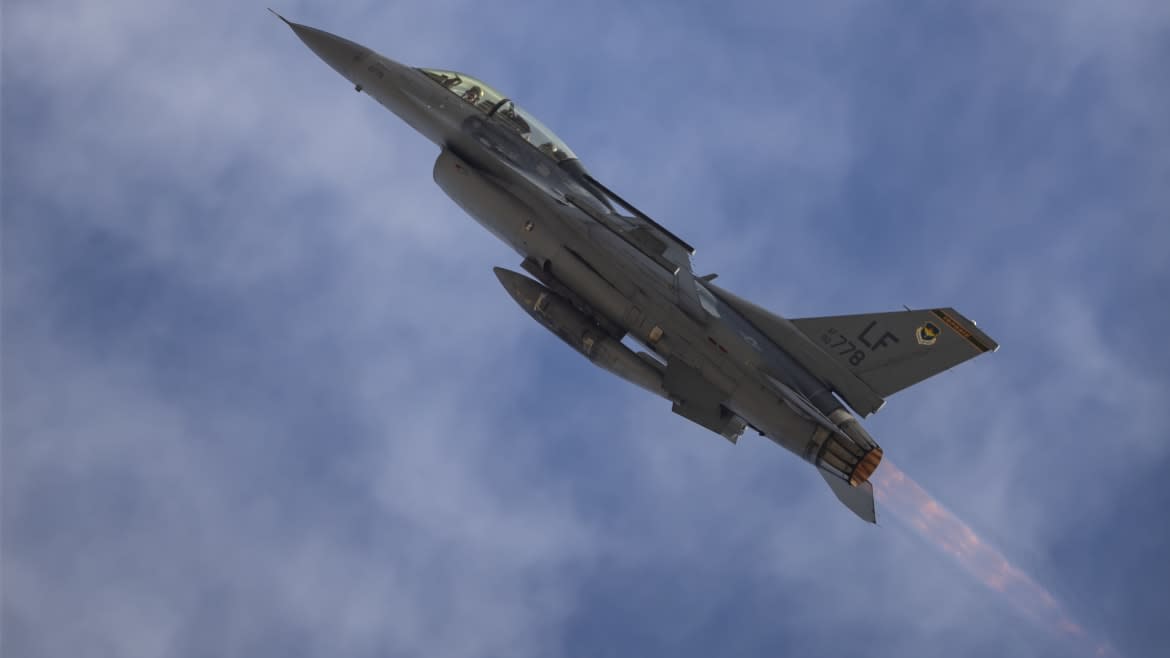An AI Successfully Flew an F-16 Fighter Jet for 17 Hours

As if we didn’t have enough to worry about with AI taking over the world and mysterious objects flying through the sky, the U.S. military decided to up the ante by creating a bot that can fly a fighter jet by itself.
The Defense Advanced Research Projects Agency (DARPA) announced on Feb. 13 that it successfully tested an F-16 test aircraft with an AI software that flew the aircraft for 17 hours. The plane, called the Variable In-flight Simulator Test Aircraft (VISTA) X-62A, took flight in December 2022 at the Air Force Test Pilot School in California.
Though we’ve seen autopilot features be used on airplanes before, this marks the first time that a bot has ever taken control of a fighter plane—and could one day open the doors for fully autonomous and uncrewed jets piloted entirely by AI.
“VISTA will allow us to parallelize the development and test of cutting-edge artificial intelligence techniques with new uncrewed vehicle designs,” M. Christopher Cotting, the director of research for the U.S. Air Force Test Pilot School, said in a statement. He added that the system “will rapidly mature autonomy for uncrewed platforms and allow us to deliver tactically relevant capability to our warfighter.”
Of course, this sort of thing probably conjures up more images of Skynet going live and killing all of humanity in The Terminator than it does the high-flying stunts of Top Gun. However, the software is actually designed to allow the VISTA to mimic other planes. That means that student pilots can train to fly everything from the massive B-52 bomber to smaller fighter jets all on the F-16.
A recent upgrade called the System for Autonomous Control of Simulation allowed the VISTA to test its autonomous F-16 AI. Using the software, the plane was capable of taking off and landing by itself as well as performing “against various simulated adversaries, and with simulated weapons capabilities,” Lt. Col. Ryan Hefron, program manager for the Aerial Combat Evolution (ACE) program at DARPA, said in a statement.
It should be noted that a pilot was on board to make sure that there was a human to grab the sticks and take over in case it wanted to go rogue. Hefron added that the AI allowed pilots to learn more about how to respond to certain situations in and out of aerial combat.
DARPA launched the ACE program in 2019 in order to research and incorporate AI into its jet fighters. The idea is that autonomous warfighters can help give human pilots a leg up during dogfights. The program is also a part of a larger movement within the Department of Defense to embrace AI and use it to bolster the country’s defense and national security. In 2022, the U.S. spent nearly $3 billion on AI research alone.
The implications are fairly horrifying. For one, having an autonomous F-16 means that bots will now be able to potentially engage enemy aircraft—something UAV drones cannot do. Also unlike a UAV, an F-16 can carry a much larger payload of 20,000 lbs compared to a drone’s 3,800 lbs. It’s a vastly more sophisticated and deadly weapon, and now the U.S. military wants to have a robot control it.
On top of all this, AI doesn’t exactly have a sterling track record—having been known to fall prey to racism, sexism, bias, and hallucinations. The consequences of relying on artificial intelligence are already pretty dire when using them for things like home loans or sentencing hearings. Imagine what happens when the stakes are as high as World War III.
Get the Daily Beast's biggest scoops and scandals delivered right to your inbox. Sign up now.
Stay informed and gain unlimited access to the Daily Beast's unmatched reporting. Subscribe now.

